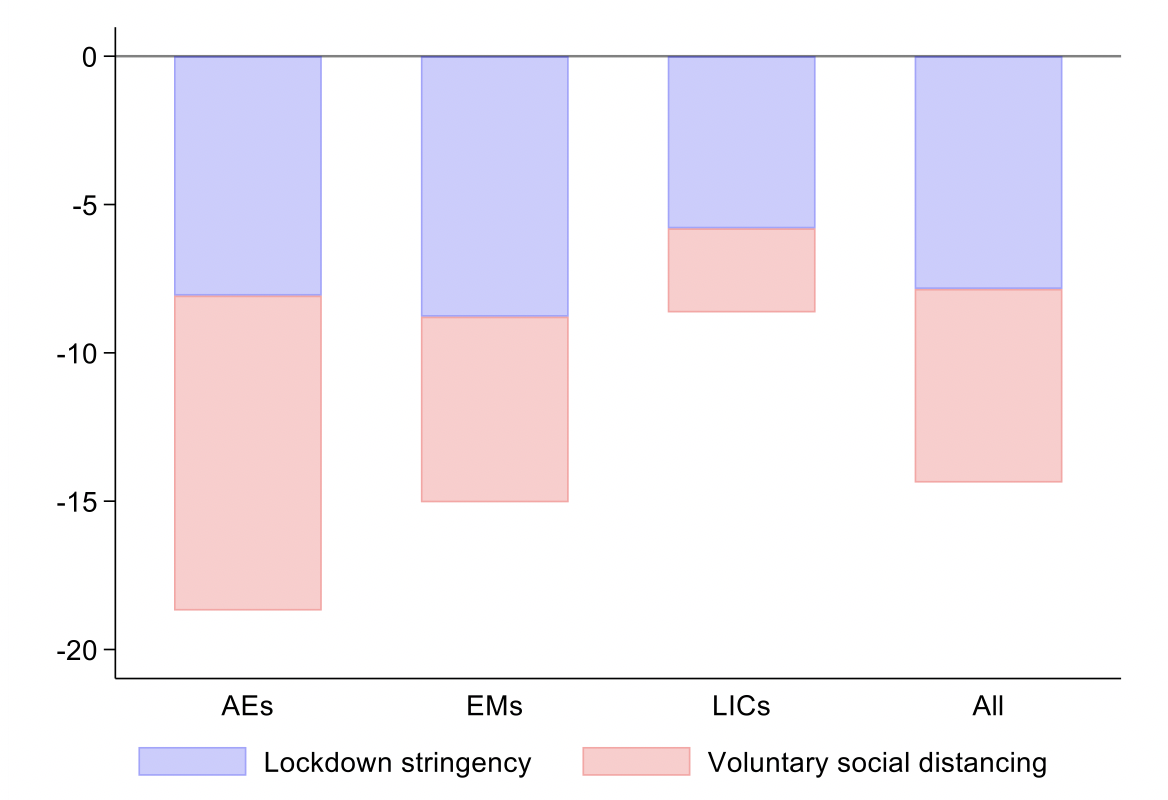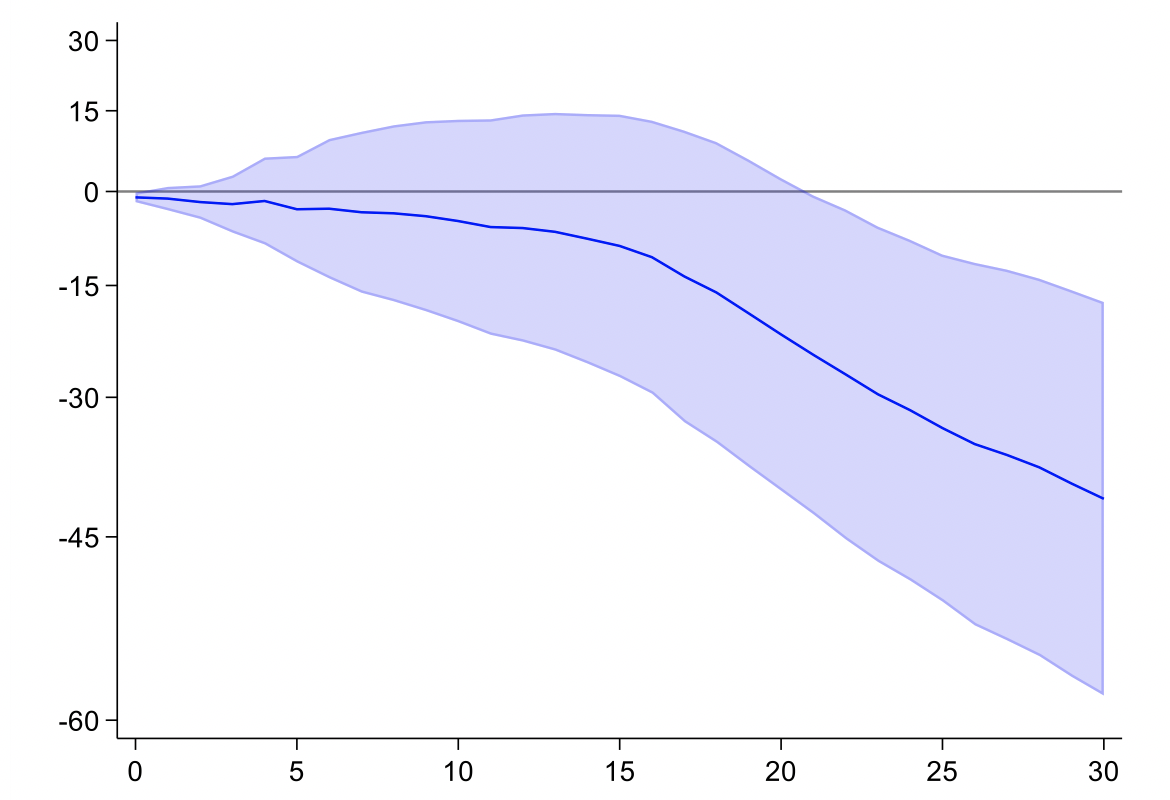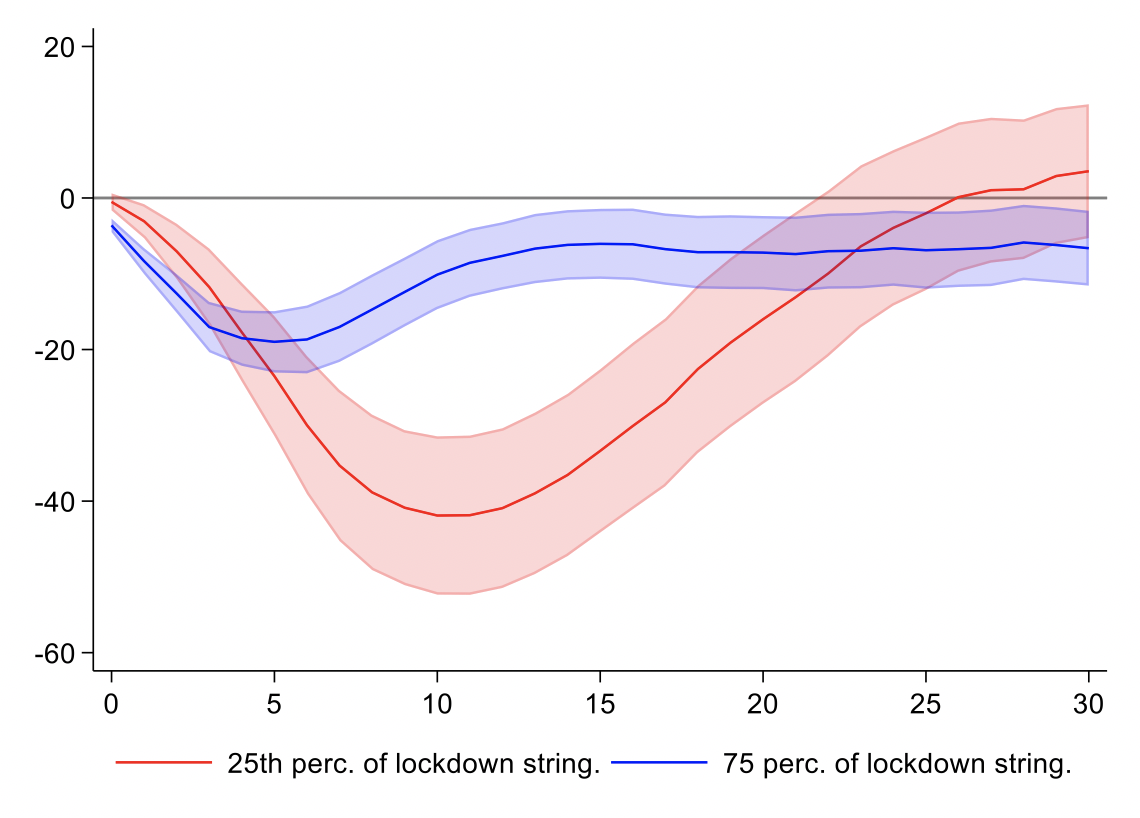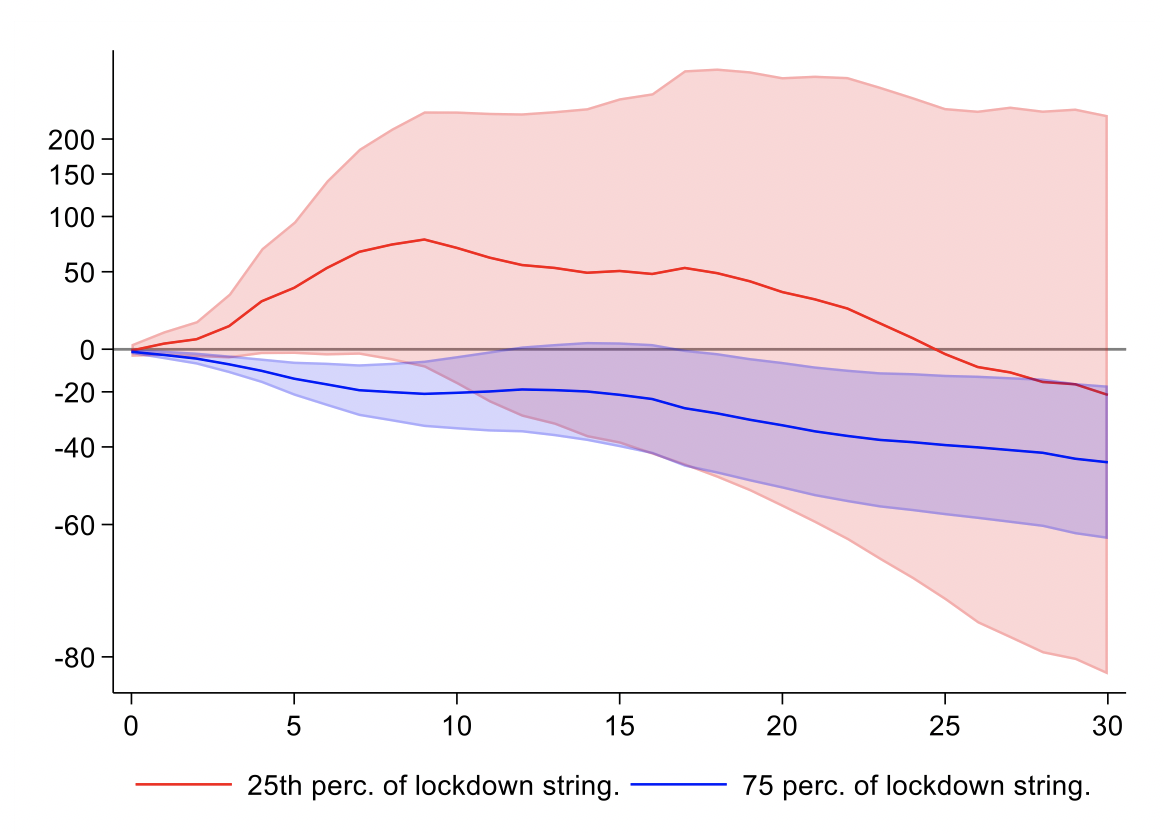The recent resurgence of COVID-19 cases in many countries continues to animate the discussion about the desirability of new lockdown measures. Before a vaccine becomes available, non-pharmaceutical interventions remain key to slow the spread of the COVID-19 pandemic (Chernozhukov et al. 2020, Dave et al. 2020, Forsythe et al. 2020, Glaeser et al. 2020, Jinjarak et al. 2020).
Lockdowns, however, impose considerable short-term economic damage (Baker et al. 2020, Beland et al. 2020, Carvalho et al. 2020, Chronopoulos et al. 2020, Coibion et al. 2020). In our work (Caselli et al. 2020), we provide a novel perspective on the costs and benefits associated with these measures.
Lockdowns harm the economy, but so does an uncontrolled increase in infections
We assess the impact of lockdowns on mobility during the first seven months of the pandemic using a large set of countries, including advanced, emerging, and developing countries. This is a challenging task since the decision to deploy lockdowns is not random. Governments are more likely to impose lockdowns when health risks become more acute. At the same time, people tend to voluntarily reduce social interactions because they fear being infected or infecting others.
To assess the impact of lockdowns on mobility, we estimate local projections controlling for the stage of the pandemic as well as country and time fixed effects. We capture lockdown stringency with the Oxford Coronavirus Government Response Tracker stringency index.
We find that a full lockdown – which includes all measures used by governments – leads to a 25% decline in mobility a week after the lockdown is introduced. We validate these findings using a stronger identification strategy on a smaller sample of countries based on the observation that governments often introduced lockdowns on a national scale in reaction to localised outbreaks. Thus, the adoption of national lockdowns was largely exogenous to the conditions prevailing in those regions that had few COVID-19 infections. The effects of national lockdowns on the mobility in regions less affected by COVID-19 are in line with the findings at the national level.
While lockdowns clearly harmed economic activity, they were not the only factor that caused the recession. The fear of contracting and spreading the virus also led people to refrain from activities that involved social interactions, which in turn took a severe toll on economic activity (e.g. Chetty et al. 2020, Goolsbee and Syverson 2020, Maloney and Tasking 2020). Our analysis shows that a doubling of daily COVID-19 cases leads to a contraction in mobility by about 2%.
These estimates imply that lockdowns and voluntary social distancing played a roughly similar role in driving the contraction in mobility across our full set of countries (Figure 1). The contribution of voluntary social distancing was stronger in advanced economies, likely because people can work from home more easily and can even afford to stop working temporarily by relying on personal savings and social security benefits. In contrast, voluntary social distancing was limited in low-income countries where the drop in mobility was mostly due to lockdowns.
Figure 1 Contribution of lockdowns and voluntary social distancing to decline in mobility
Notes: The bars denote the cross-country average contributions of lockdowns and voluntary social distancing to the decline in mobility, computed using the coefficients on lockdowns and the log of daily COVID-19 cases multiplied by the average of the corresponding variables for each country group during the first three months of each country’s epidemic.
Lockdowns can contain the spread of COVID-19
Lockdowns engender sizeable short-term economic costs, but they are also an investment in public health. We find that a stringent lockdown reduces the cumulative number of infections by about 40% over a month (Figure 2a). It takes a couple of weeks for lockdowns to have an effect on infections, consistent with the virus’s incubation period and the time required for testing; this is an important feature to guide people’s expectations about the effectiveness of lockdowns.
Lockdowns appear particularly effective in containing infections if they are adopted early (Figure 2b). In our analysis, we compare the epidemiological outcomes of early and late lockdown adopters 90 days after the first COVID-19 case. We find that those countries that tighten lockdown restrictions when cases were still relatively low witnessed much fewer infections over time.
Figure 2 Impact of lockdowns on COVID-19 infections
(a) Impact of a full lockdown on infections
(b) Infections since the start of the countries’ epidemics for tighteners with few and many cases
Notes: In panel (a), the horizontal axis denotes the number of days, the line denotes the point estimates, and the shaded area corresponds to 90% confidence intervals computed with standard errors clustered at the country level; a full lockdown includes all measures used by governments during the pandemic. In panel (b), the lines denote the medians and the shaded areas correspond to the interquartile ranges; countries are split into tighteners with few cases and tighteners with many cases based on the cross-country median number of COVID-19 cases at the time in which the maximum lockdown stringency was reached.
Tight versus mild lockdowns
We also compare the economic and health effects between mild and stringent lockdowns. Lockdowns appear to entail decreasing marginal economic costs but increasing marginal health benefits. Figure 3a shows that tightening lockdowns when the overall stringency level is already elevated has a weaker impact on mobility than when the lockdown stringency is low. For example, stay-at-home orders may have only a modest negative impact on economic activity if governments have already imposed school and business closures.
In contrast, Figure 3b shows that lockdowns are effective in reducing COVID-19 cases only if they are sufficiently stringent. A possible interpretation is that preventing only a few instances of personal contacts – such as by closing schools alone – is not enough to significantly reduce community spread.
Figure 3 Nonlinear effects of lockdowns
(a) Impact on mobility
(a) Impact on infections
Notes: The horiztonal axes denote the number of days, the lines denote the point estimates, and the shaded areas correspond to 90% confidence intervals computed with standard errors clustered at the country level.
The findings imply that if policymakers want to achieve a given reduction in infections, they should lean towards stringent and short-lived lockdowns rather than rely on prolonged mild measures.
Implications
The combined finding – that early and tight lockdowns are effective in reducing infections and rising infections can considerably harm economic activity – offers a new perspective on the overall costs of lockdowns. The prevailing narrative often portrays lockdowns as involving a trade-off between saving lives and supporting the economy. This characterisation applies in the short run, but it neglects that lockdowns may lead to a faster economic recovery by containing the virus and reducing voluntary social distancing. Therefore, early and tight lockdowns may hold the key to confront new epidemic waves by protecting both lives and livelihoods.
References
Baker, S R, R A Farrokhnia, S Meyer, M Pagel and C Yannelis (2020). “How does household spending respond to an epidemic? Consumption during the 2020 COVID-19 pandemic”, NBER Working Paper 26949.
Beland, L-P, A Brodeur and T Wright (2020). “COVID-19, stay-at-home orders and employment: Evidence from CPS data”, IZA Discussion Paper 13282.
Carvalho, V M, S Hansen, A Ortiz, J Ramon Garcia, T Rodrigo, S Rodriguez Mora and P Ruiz de Aguirre (2020). “Tracking the COVID-19 crisis with high-resolution transaction data“, CEPR Discussion Paper DP14642.
Caselli, F, F Grigoli, W Lian and D Sandri (2020), “Protecting Lives and Livelihoods with Early and Tight Lockdowns”, IMF Working Paper 20/234.
Chernozhukov, V, H Kasaha and S Paul (2020). “Causal impact of masks, policies, behavior on early Covid-19 pandemic in the US“, COVID Economics 35.
Chetty, Raj, J N Friedman, N Hendren, M Stepner, et al. (2020). “How did COVID-19 and stabilization policies affect spending and employment? A new real-time economic tracker based on private sector data”, NBER Working Paper 27431.
Chronopoulos, D K, M Lukas and J O S Wilson (2020). “Consumer spending responses to the COVID-19 pandemic: An assessment of Great Britain”, SSRN 3586723.
Coibion, O, Y Gorodnichenko and M Weber (2020). “The cost of the COVID-19 crisis: Lockdowns, macroeconomic expectations, and consumer spending”, NBER Working Paper 27141.
Dave, D, A I Friedson, K Matsuzawa and J J Sabia (2020). “When do shelter-in-place orders fight COVID-19 best? Policy heterogeneity across states and adoption time”, Economic Inquiry.
Forsythe, E, L B Kahn, F Lange and D Wiczer (2020). “Labor demand in the time of COVID-19: Evidence from vacancy postings and UI claims”, Journal of Public Economics 189: 104238.
Glaeser, E L, C S Gorback and S J Redding (2020). “How much does COVID-19 increase with mobility? Evidence from New York and four other US cities”, NBER Working Paper 27519.
Goolsbee, A, and C Syverson (2020). “Fear, lockdown, and diversion: Comparing drivers of pandemic economic decline”, NBER Working Paper 27432.
Jinjarak, Y, R Ahmed, S Nair-Desai, W Xin and J Aizenman (2020). “Accounting for global COVID-19 diffusion patterns, January–April 2020”, NBER Working Paper 27185.
Maloney, W, and T Taskin (2020). “Determinants of social distancing and economic activity during COVID-19: A global view”, The World Bank Policy Research Working Paper 9242.












